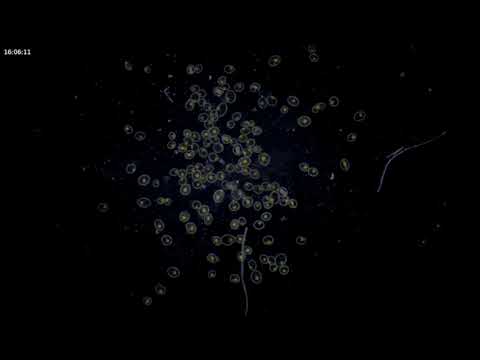Microscopic plankton are at the heart of the ocean’s food chain, feeding much bigger animals like whales. However, not much is known about how single-celled phytoplankton–most of which don’t have any appendages that help them swim–get around. They journey up from the darkest and coldest depths of the ocean up to the surface, only to drift down again. One species of bioluminescent phytoplankton called Pyrocystis noctiluca does this by ballooning six times its normal size. This inflation then takes the usually only a few hundred micron-wide plankton about 656 feet up towards the ocean’s surface, so that it can capture sunlight to make food. This unique strategy for ocean travel is described in a study published October 17 in the Cell Press journal Current Biology.
“What we have discovered in this paper is that these P. noctiluca cells are like little submarines that can control their density so precisely that they can choose where they want to be in the water column,” study co-author and Stanford University marine biologist and bioengineer Manu Prakash said in a statement.
[Related: NASA’s PACE satellite takes off to monitor phytoplankton—from space.]
On average, phytoplankton are only five to 10 percent heavier than seawater. This means if they want to remain at the surface of the ocean to photosynthesize, they have gravity to contend with.
While on a research vessel off Hawaii, Prakash and a postdoctoral fellow at Stanford University and study co-author Adam Larson saw a bloom of P. noctiluca. Surprisingly, there were two very different sizes of plankton in their nets.
“It took a while to piece together why until we recorded the videos where we saw the cells doing this massive inflation,” Larson said in a statement. “It can happen quite suddenly, so if you sleep by the microscope for 10 minutes, you might miss it.”
In the study, they tested what effects this rapid growth may have on the plankton. To do this, they developed a tool called a gravity machine.
“The gravity machine allows us to see a single cell at subcellular resolution in an infinite water column,” said Prakash. “It’s a little bit like a Ferris wheel for gerbils or mice but for a single cell. It’s the size of a dinner plate and rotates, so the cell doesn’t know that it’s not climbing or sinking in its own frame of reference.”
Altering the water pressure and density within the gravity machine creates a virtual reality environment that mimics the ocean’s depths. With the machine, the team found that the inflated cells were less dense than the surrounding seawater. This lets them escape gravity’s downward pull and float toward the virtual surface.
A closer look showed that this expansion occurs as a natural part of the plankton’s cell cycle. After a single-celled plankton divides into two, an internal structure called a vacuole filters in freshwater. This causes the two new cells to massively grow in size. The two daughter cells that are then swelled with the lighter freshwater and sail upward.

The Pyrocystis cell cycle. Part 1 shows the Pyrocystis’ life cycle. Part 2 shows the cell wall breaking down. Part 3 shows the cell inflating. Part 4 details the dynamics that occur in the cytoplasm after division. CREDIT: Larson et al./Current Biology
VIDEO: The Pyrocystis cell cycle. Part 1 shows the Pyrocystis’ life cycle. Part 2 shows the cell wall breaking down. Part 3 shows the cell inflating. Part 4 details the dynamics that occur in the cytoplasm after division. CREDIT: Larson et al./Current Biology
“What we realized is that this is a very clever way to essentially slingshot in the ocean during cell division,” Prakash said. “So, what happens during normal time? You’re making a lot of proteins, you have tons of sunlight, and you make a lot of biomass until you get heavier and you sink. Then, you do cell division in the deeper waters and use inflation to get back to the size of the mother.”
This entire cell cycle takes about seven days and coincides with when the plankton embarks on its upward pursuit of sunlight and nutrients. According to Prakash, this is potentially the first clear evidence that this cell cycle is controlled by an ecological parameter.
“All cells experience a gravitational pull downward, and unless they or subsequent progeny fight back, they will sink forever to the bottom of the ocean in a gravitational trap,” study co-author and Stanford University postdoctoral fellow Rahul Chajwa said in a statement.
Using the results from the gravity machine, as well as their ecological and physiological observations, the team developed a mathematical framework that could be applied to all plankton in the ocean. The team hopes to uncover more of the hidden mysteries of a large number of lpankton who may use biochemistry to regulate density and move up and down the water column.

